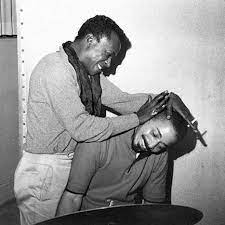Dive into the Power & Passion of ‘Tenor Madness
In the vast panorama of jazz, Sonny Rollins’ “Tenor…
As I listened to Miles Davis‘ “Someday My Prince Will Come,” I felt a sense of awe and admiration. The sheer creativity overflowing from this song is undeniable, and it serves as an inspiration that refreshes my soul no matter how many times, I hear it. This masterpiece has an incredible ability to transport the listener to a place of inspiration and joy, so let’s dive into what makes it so special!

The Columbia 30th Street Studio in New York City has earned its place in history as the birthplace of some of jazz’s most legendary masterpieces, such as Miles Davis’ “Someday My Prince Will Come”, which was recorded and released by Columbia Records in 1961. This iconic apartment is a veritable time-capsule of creativity, with each composition within its walls standing out in each their own unique way. “Someday My Prince Will Come” is no exception, possessing an indescribable beauty that has mesmerized listeners since 1961.
Miles Davis, a titan of jazz, led a quintet of exceptional musicians during this session. Hank Mobley‘s tenor saxophone graced the ensemble, filling the void left by the departing John Coltrane, who nevertheless made a guest appearance. Wynton Kelly‘s piano, Paul Chambers‘ bass, and Jimmy Cobb‘s drums provided the rhythmic foundation, with Philly Joe Jones drumming on “Blues No. 2.”

The album blends hard bop and modal jazz, showcasing the musicians’ fluidity and virtuosity. Mobley’s laid-back, melodic style contrasts sharply with Coltrane’s intense, exploratory approach. This collision of saxophone titans creates a rich tapestry of sound, with each track evoking a unique emotional landscape.

Every track on this album is a treasure, showcasing the diverse talents of the musicians involved. The title track, “Someday My Prince Will Come,” is an enchanting waltz that breathes new life into a Disney classic. Coltrane’s passionate solo and Kelly’s playful piano meld beautifully, transforming the song into a captivating jazz standard. Each note carries the listener away on a whimsical journey that dances between fantasy and reality.

“Old Folks” is a tender, introspective ballad that highlights Davis’ warm, lyrical trumpet and Mobley’s soulful saxophone. The piece exudes a sense of nostalgia, inviting the listener to reflect upon cherished memories and bittersweet moments of the past. “Pfrancing,” an upbeat and lively number penned by Davis himself, demonstrates the quintet’s seamless interplay and infectious swing. The energetic tune resonates with the listener, creating an atmosphere of joy and celebration.
As we delve deeper into the album, “Drad-Dog,” another Davis original, offers a bluesy canvas for Kelly’s piano to shine alongside the leader’s muted trumpet. “Teo,” named for the album’s producer Teo Macero and my personal favorite, captivates with Coltrane’s fiery, intricate solo. “I Thought About You” is a romantic standard that weaves a heartfelt narrative through Davis’ expressive trumpet and Mobley’s smooth saxophone.
Lastly, “Blues No. 2,” a bonus track on some editions, immerses the listener in a blues-infused soundscape, highlighting Philly Joe Jones’ spirited drumming. Each track on “Someday My Prince Will Come” offers a unique and memorable experience, solidifying its place as an essential album in the annals of jazz history.
Upon its release, “Someday My Prince Will Come” received acclaim from critics and audiences alike. It was lauded for its innovative blend of styles and the virtuosity of its musicians. Although it didn’t reach the same legendary status as “Kind of Blue,” it remains a significant milestone in Davis’ discography.
Today, the album’s importance and impact are undeniable. Its legacy can be felt in the works of countless musicians who have drawn inspiration from Davis and his ensemble. The contrasting styles of Mobley and Coltrane have shaped the evolution of saxophone playing, while the innovative blend of hard bop and modal jazz has left an indelible mark on the genre.
The album cover, with its striking image of Davis’ then-wife, Frances Taylor, adds another layer of artistic significance. Her captivating gaze, set against a vibrant red backdrop, conveys a sense of elegance and intrigue that perfectly complements the music within.
Contemporary jazz artists continue to find inspiration in this classic work. Its blend of styles, emotional depth, and daring improvisations have laid the groundwork for countless modern jazz explorations. Moreover, the album played a crucial role in the careers of its musicians. It marked a turning point for Coltrane, who would soon embark on his groundbreaking solo journey. For Mobley, it solidified his place among the jazz greats.
In conclusion, “Someday My Prince Will Come” stands as a testament to the brilliance of Miles Davis and his quintet. This timeless album showcases the creative prowess of each musician while pushing the boundaries of jazz. Its innovative blend of styles and emotional depth continue to captivate and inspire both seasoned jazz enthusiasts and new listeners alike. If you haven’t yet experienced the magic of this album, I encourage you to give it a spin and let the music transport you to a world of sonic exploration and emotional resonance.